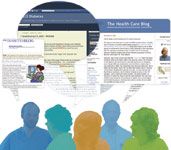Alternative Media: Patient Bloggers on Your Brands
Marketers can leverage thetransparency of the Web by listening in and mining thousands of conversations about their clients' brands.
Self-expression has taken many forms over the years. Starting with bulletin boards in the 80s, then Web sites, and now weblogs or "blogs," it is becoming increasingly easier for individuals to voice their opinions. Patients seem to think so too. A growing number of them have recently turned to blogs to discuss medical issues, record their experiences, and give and seek advice about treatments. While patients may be distrustful of pharma, they see each other as credible sources of information. In fact, they often trust the advice of their peers more than they trust their physician. Some patients even"play doctor" on these blogs, offering brand endorsements and medication recommendations. While these product testimonials can credential a medication in the same way that user reviews drive sales for the latest gadgets, patients venting their frustrations or dissatisfaction with a medication can also do considerable damage to a company's marketing efforts. Either way, this information can be very valuable for pharma. Marketers must figure a way to leverage this insight to build better brands.

Gina Ashe
Powerful Peer Networks
Marketers must first identify why these blogs wield such influence over consumers. First, patients feel that blogs give them access to the "real truths" about medications, instead of the perceived untruths that pharma serves up. Even though many blogs lack credentialed sources, patients still tune in because they relate to real-life experiences and first-hand accounts. Second, many feel that in order to gain the upper hand on their disease, they need a wider network of authorities than just their physician or pharma-sponsored educational materials about drug therapies. While physicians still play the primary role in prescribing a drug treatment, an MD's perspective does not always address all of the disease-related issues that impact a patient's life, particularly the emotional ones. Nor are physicians available 24/7, unlike blogs, which function at all hours.

Diabetes Case Study
Marketers can utilize blogs by harvesting conversation strings that include terms or phrases that interest them. In one example, pharma marketers promoting a diabetes treatment analyzed more than 390,000 conversations that included the terms "diabetes," "low carb," and "insulin levels." They were looking for:
- Leaders and influencers Who are the people leading the conversations? Where are they in the disease cycle? What is the criterion or expertise that has sanctioned them as an influencer on this topic?
- Attitudes and motivations What are their attitudes about the condition and receiving treatment? What are their attitudes about available drugs? Do they respect the diagnosis of healthcare providers?
- Novice questions and veteran answers What kinds of questions are people asking and what kinds of answers are they receiving from those who claim to be in-the-know? What is their understanding of the condition and the different treatment options?
- Location and involvement What kinds of conversations are the disease or brand a part of? Where are these converstaions taking place? Are they in disease-specific forums or more broadly based conversations embedded within larger lifestyle sites?
- Conversation content What aspects of the condition or medication make up the conversation? Is it the pursuit of finding the right treatment? What is the impact of the medication or disease on family or work life? Side effects? Financial issues? The search for improved quality of life?
- Shifting patterns over time Is the online diaogue a reaction to new product entries, scientific advances, or other marketplace events?
When looking at the diabetes conversations, marketers found that only 10 percent of all online conversations revolved around the efficacy of drug therapies. They learned that people were less concerned about the drug's efficacy because they presumed that all the medications in this category were interchangeable. Instead, patients were primarily concerned with how diabetes affects patients' diets and food choices. They also found that patients who developed coping strategies represented the authority figures in this category.
These insights enabled marketers to design a customer resource managment (CRM) program that identified "copers" and "non-copers." They paired non-copers (often newly diagnosed patients) with "copers" to get tips, advice, and support. The program set up a Web site from which both copers and non-copers could benefit. The site offers diabetics the opportunity to explore areas of personal interest or concern and download practical tips and advice from cyber-experts.
Patient Triggers
Blogs can help marketers understand how customer attitudes and motivations form and change. By creating markers that track a patient's progress over time, pharma can determine what kind of message to send them and when to do so. This content-timing formula needs to be precise to gain credibility and acceptance from the patient. It also gives pharma an understanding of the trigger events, which often include a combination of behavioral and emotional events that indicate when a patient may be ready to learn more about a product.
Marketers may want to examine:
- How patients feel about the disease
- How much the disease impacts their quality of life
- Whether they buy into the doctor's diagnosis and the treatment prescribed
- How they perceive the effectiveness of treatments.
For example, if a patient is generally suspicious of doctors or afraid of injections, he may not be a good candidate for an injectable drug therapy. However, if he reaches a point where his condition is affecting his quality of life, he may be open to considering alternative treatments.
Neurologic Drug Case Study
In another example, marketers evaluated 120,000 conversations as part of online anthropology work for a new neurologic drug. They found that patients primarily talked about drug therapies. The online "experts" were those who had tried the most number of treatments. Research found that patients felt their condition left them at a disadvantage in society and unable to lead what they perceived to be normal lives. To gain credibility and add relevancy for these patients, marketers started to provide information on travel, finance, and patients' rights in their marketing materials. This empowered patients and gave them the support and tools to help them gain equal status in society.
Blogs reinforce that patients value healthcare information on a personal level. They give marketers insight into disease-related issues that overwhelm patients and help identify barriers to their treatment. Marketers should listen to the new consumer-powered conversations in order to understand what triggers patients to switch products or develop loyalty to them. The transparency of the Web offers a unique opportunity to market more effectively than ever before. Through blogs, marketers can raise issues that are important to patients, test the pervasiveness of a concern (positive or negative) and ultimately, revamp their marketing strategies.
People TelaDoc selected Steven W. Cooley as president of operations and liason to the Teladoc Physicians' Association. Blue Diesel hired five new people: Jennifer Burkhardt as account manager, Nicholas Carron as senior interactive designer, Bryan Duffie as interactive designer, Aaron Reiser as interactive art director, and TJ Sochor as media specialist.

Genetown Hotbed and BioGarden Hotbed
Launches BioSpace launched two promotional campaigns: Genetown Hotbed, in conjunction with the Massachusetts Biotechnology Council, and BioGarden Hotbed, in conjunction with the Biotechnology Council of New Jersey.
Awards Two Scinexa programs won gold Davey awards: "Reflections of Memories Lost: Understanding Alzheimer's Disease" and "Special Considerations in the Treatment of Geriatric Epilepsy." Cadient Group won an eHealthcare Leadership Silver Award of Excellence for a campaign about Alpha 1-proteinase inhibitor therapy. The Cadient Group was also a finalist at the MIXX awards for a campaign about atypical antipsychotics. It was the only pharma company recognized at the 2005 MIXX awards.
Gina Ashe is director of Rapp Collins Healthcare. She can be reached at asheg@rappcollins.com
